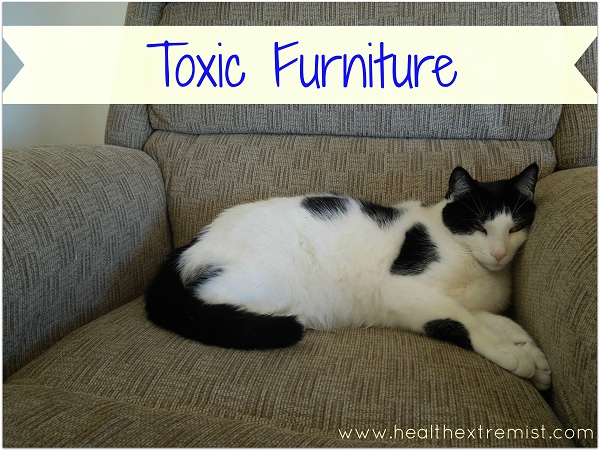This post may contain affiliate links. Please read my disclosure.
Toxic Furniture in Your Home
Cancer Causing Chemicals in Your Living Room from Toxic Furniture
So you’ve tried to remove all of the toxic chemicals in your home, but there’s one major one you probably don’t know about!
It’s your furniture! Did you know that your furniture is actually toxic furniture!
Upholstered furniture is heavily sprayed with chemicals which are known carcinogens to make them flame retardant.
Several studies have found harmful flame retardants in nearly every couch test.
Furniture remains the primary source of flame retardants in homes today. These flame retardants are harmful to health as they have been found to be present in our bodies.
One recent study found 3 out of every 4 couches purchased prior to 2005 to contain harmful chemicals which are now banned due to carcinogenic affects. Of all couches, 94% contained flame retardants! The use of flame retardants has significantly increased over the past decade.
What & Why are these Harmful Chemicals in Our Furniture?
Over six different flame retardant chemicals were found on the majority of couches. One of the most prevalent chemicals was Tris, a known carcinogen, which was banned from use in baby pajamas due to the harmful affects on health.
Another flame retardant, PentaBDE, was found in over 39% of the couches tested. PentaBDE has been linked to impaired neurological development, thyroid dysfunction, and cognitive impairments.
Both of these chemicals, Tris and PentaBDE were phased out of use by 2005. However, most of us still have furniture in our homes purchased prior to 2005! What happened to furniture after 2005? Flame retardants were and are still used at the same capacity, but new flame retardant chemicals replaced the ones used earlier.
The concentration of the chemicals in toxic furniture, accounts for anywhere between 5% of the weight of the couch to 11%!
Toxic Furniture Chemicals Found in Household Dust
So, how do these chemicals affect your health?
The flame retardants in toxic furniture break down and contaminate dust. We end up breathing in the chemicals in addition to other ways they can make it into our bodies.
Children who commonly play on the ground were found to be at an even higher risk of being exposed through dust. The existence of these harmful chemicals in our bodies was shown through detecting the presence of it in blood level tests.
Homes in California were found to have such high levels of flame retardants in the air, that it was determined hazardous by the Environmental Protection Agency.
Why Should We Be Concerned About Toxic Furniture?
We do know that the flame retardants are extremely harmful to our health. Flame retardant chemicals have been linked to cancer, neurological effects, and infertility.
Studies have shown that nearly every American has measurable levels of flame retardants in their body. This level was found to be at least 3 times higher in children, by EWG.
There is enough information to be concerned about the presence of flame retardants in our homes.
According to a study published on preventing cancer;
“Only 5–10% of all cancer cases can be attributed to genetic defects, whereas the remaining 90–95% have their roots in the environment and lifestyle.” source
Even though there isn’t enough research in this area, the limited amount there is, shows that taking the extra precaution of trying to eliminate these chemicals from your home will reduce the amount absorbed into your body.
Solution for Toxic Furniture:What to do
It would be best to remove all of the toxic furniture in your home. But, unfortunately most of us can’t afford to that.
(If you are buying new furniture, make sure to buy organic and flame retardant free furniture)
Simple ways to reduce harmful affects of toxic furniture:
1. Reduce household dust- the primary way the chemicals make into our bodies is through dust.
—Use an air filter
—Vacuum with a HEPA-filter
—Wipe down all surfaces where dust may accumulate
2. Open your windows – circulate air and reduce contaminates
3. Spend as much time as you can outdoors
4. Take extra precautions for children who spend the majority of time on the floor
Sources:
http://www.npr.org/blogs/health/2012/11/28/166085563/flame-retardants-from-furniture-found-in-household-dust
http://www.environmentalhealthnews.org/ehs/news/2012/toxic-couches
http://www.mnn.com/your-home/at-home/stories/toxic-couches-flame-retardants-on-the-rise-in-furniture-study-finds
Linked on: Party Wave Wednesday, Thank Your Body Thursday


Leave a Reply